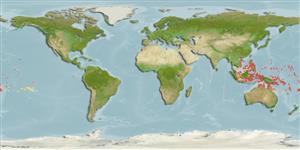>
Atheriniformes (Silversides) >
Atherinidae (Silversides) > Atherinomorinae
Etymology: Stenatherina: Greek, stenos =narrow + Greek, atherina, the Greek name for the eperlane; 1770 (Ref. 45335).
More on authors: Jordan & Richardson.
Environment: milieu / climate zone / rango de profundidad / distribution range
Ecología
marino asociado a arrecife; rango de profundidad 1 - 20 m (Ref. 86942). Tropical; 19°N - 20°S
Pacific Ocean: Sumatra and the northern Cook Islands, north to the Philippines, Caroline Islands, and Marshall Islands, south to Fiji.
Tamaño / Peso / Age
Madurez: Lm ? range ? - ? cm
Max length : 11.0 cm TL macho / no sexado; (Ref. 9760)
Short description
Claves de identificación | Morfología | Morfometría
Espinas dorsales (total) : 5 - 8; Radios blandos dorsales (total) : 8 - 10; Espinas anales: 1; Radios blandos anales: 9 - 12. Vomerine teeth forming a characteristic T pattern. Ascending process of premaxilla long, extending past orbit into interorbital space; lateral process very long and pungent. Gill rakers long and slender, longer than half the diameter of pupil. Interdorsal scales 8-10. Distinct crescentic mark present on snout immediately in front of eye; upper part of midlateral band terminating as half crescent on upper lobe of caudal fin.
Body shape (shape guide): elongated; Cross section: oval.
Preferred habitat appears to be deeper enclosed atoll lagoons, reefs, coastal waters and harbors. May gather in schools at night when attracted to light but generally not found in very large numbers. May be taken as food by larger commercial species (Ref. 9760).
Life cycle and mating behavior
Madurez | Reproducción | Puesta | Huevos | Fecundidad | Larva
Oviparous, distinct pairing during breeding (Ref. 205).
Myers, R.F., 1991. Micronesian reef fishes. Second Ed. Coral Graphics, Barrigada, Guam. 298 p. (Ref. 1602)
IUCN Red List Status (Ref. 130435: Version 2025-1)
Threat to humans
Harmless
Human uses
Pesquerías: escaso valor comercial; carnada: occasionally
Herramientas
Special reports
Download XML
Fuentes de Internet
Estimates based on models
Preferred temperature (Referencia
123201): 26.7 - 29.3, mean 28.7 °C (based on 1304 cells).
Phylogenetic diversity index (Referencia
82804): PD
50 = 1.0000 [Uniqueness, from 0.5 = low to 2.0 = high].
Bayesian length-weight: a=0.00562 (0.00240 - 0.01320), b=3.15 (2.95 - 3.35), in cm total length, based on LWR estimates for this (Sub)family-body shape (Ref.
93245).
Nivel trófico (Referencia
69278): 3.3 ±0.4 se; based on size and trophs of closest relatives
Resiliencia (Referencia
120179): Alto, población duplicada en un tiempo mínimo inferior a 15 meses (Preliminary K or Fecundity.).
Fishing Vulnerability (Ref.
59153): Low vulnerability (10 of 100).
🛈
Nutrients (Ref.
124155): Calcium = 109 [59, 211] mg/100g; Iron = 0.693 [0.404, 1.257] mg/100g; Protein = 19.4 [17.1, 21.8] %; Omega3 = 0.14 [0.06, 0.36] g/100g; Selenium = 21.7 [10.3, 49.4] μg/100g; VitaminA = 181 [57, 527] μg/100g; Zinc = 1.82 [1.23, 2.59] mg/100g (wet weight);
